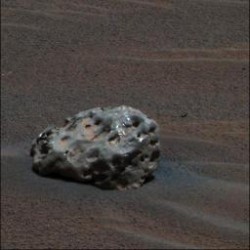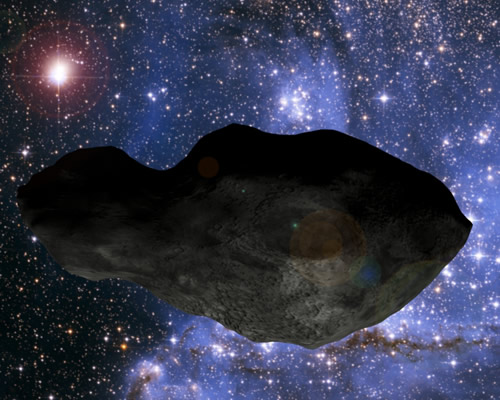[/caption]
Meteorites and asteroids from the inner solar system could be responsible for Earth’s store of precious metals such as platinum and iridium, brought to our nascent planet during the period of Late Heavy Bombardment, about 4,000 million years ago. Dr. Gerhard Schmidt from the University of Mainz, Germany, has calculated that about 160 metallic asteroids of about 20 kilometers in diameter would be sufficient to provide the concentrations of these metals, known as Highly Siderophile Elements (HSE), found in the Earth’s crust. “A key issue for understanding the origin of planets is the knowledge of the abundances of HSE in the crust and mantle of the Earth, Mars and the Moon. We have found remarkably uniform abundance distributions of HSE in our samples of the Earth’s upper crust. A comparison of these HSE values with meteorites strongly suggests that they have a cosmo-chemical source,” said Schmidt.
Schmidt and his colleagues have spent the last 12 years analyzing the concentrations of HSE at meteorite impact sites around the world, as well as in the samples from the Earth’s mantle and crust. In addition, he has compared the data from the Earth with data from impact breccias from the Moon brought by the Apollo missions and Martian meteorites, believed to be samples from the mantle and crust on Mars.
As the Earth formed, the heavy elements, including HSE that were present, sank to form the iron and nickel-rich metallic core. HSE were added again later by meteorite impacts, creating a veneer of material over the Earth’s surface after the core had formed, about 20-30 million years after the planet’s accretion. This could have been by the collision with a Mars-sized impactor that led to the formation of the Moon.
However, Schmidt believes that the meteorites responsible for the HSE elements on Earth are iron or stony-iron meteorites that match up with theoretical predications of asteroids formed in the Mercury-Venus region of our solar system.
Different classes of meteorites have characteristic elemental ratios of HSE that give indications where in the Solar System they formed. Chondrites are stony meteorites that represent the pristine material from the early Solar System, and iron or stony-iron meteorites, which are fragments of larger asteroids that had enough internal heat in the past to form a molten metal core. These most likely would have formed in the inner solar system.
The ratios of HSE found in Earth’s crust bear a much closer resemblance to iron or stony-iron meteorites, and Schmidt believes these meteorites came from the inner solar system.
There’s a problem, however. Of the 175 known impact craters on Earth, remains of the projectiles have been found for about 40, and none of these meteorites have been identified as being formed in the region between Mercury and Venus.
Intriguingly, some of the Martian meteorites found in Antarctica, which are probably represent samples of the Martian crust also have HSE values that resemble groups of iron meteorites and stony irons, suggesting that a similar process took place on Mars.

Also, the first meteorite found on Mars by the Opportunity Mars Exploration Rover in 2005 was an iron
meteorite.
Dr. Schmidt presented his findings at the European Planetary Science Congress in Muenster on Monday, 22nd September.


Why does everything on Earth have to come from meteorite bombardment – water, precious metals, life even.
The Earth formed out of the same material as the asteroids/meteorites so I imagine everything was already here to make up almost all the water and precious minerals.
Thank you for using “thousand millions”.
…and the theory that this whole bombardment and early formation history is based upon is being challenged by the chamical makeup of Kuiperbelt objects.
….stay tuned.
jerry,
Really? Got some links? Hadn’t seen anything here about that.
Now, all I have to do is find one, mine one and, and I’ll be rich, rich I tells ya, mwuhuhauhhaaa ..
Shouldn’t the title have the ‘asteroids’ removed? I mean, how do precious metals in asteroids get to earth without first becoming meteorites?? 😛
Also, why would a rock sat squarely and gently on the surface of Mars be thought to be a meteorite? Did it parachute down to the surface? Sometimes I wonder about the so called experts in charge of science. They come up with some pretty silly things at times. Reminds me of when I was 5 and I thought the first volcanic rock I saw was a meteorite due to the holes. Seriously, what.. WHAT evidence at all is there that the rock in the last photo is a meteorite, when ALL available evidence suggests the contrary??
Assuming this theory to be valid, wouldnt the concentration of these precious metals be in the proximity of the crust close to the impacts. However i believe that´s not the case.
Or is there a chance of the meteorite composition getting randomly distributed?
“The Earth formed out of the same material as the asteroids/meteorites so I imagine everything was already here to make up almost all the water and precious minerals.”
Perhaps, but it’s been shown that for a great deal of time, hundreds of millions of years at least, the Earth was a ball of molten lava.
That would tend to destroy water and life, and made it difficult for precious minerals and metals to stay near the surface – metal sinks in lava, which is why the Earth has a metal core.